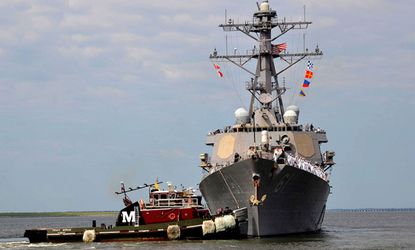What would a U.S.-China war look like?
War-gaming an extremely unlikely conflict

Imagine this: In the early morning, a barrage of more than 1,000 Chinese ballistic and cruise missiles bombard Taiwanese civilian and military targets.
As the U.S. Air Force stationed in Okinawa prepares to rush to the aid of its sworn ally, Chinese cyber attacks wreak havoc on America's air defense and targeting systems. A second volley of ballistic missiles detonates in space, destroying critical military satellites, while a third rains down on the base, damaging jets and leaving runways unusable.
Meanwhile, a U.S. carrier strike group led by the USS George Washington has launched from Japan and is steaming towards the Taiwan Strait. Without the advanced warning and additional data supplied by satellites, the group's missile defense systems are at a disadvantage against the Chinese "carrier killer" missiles that are streaking towards them. Defense systems do their best, but a few missiles still hit their mark, leaving the USS George Washington's flight deck unusable. America's awesome air and sea power has been sidelined.
Subscribe to The Week
Escape your echo chamber. Get the facts behind the news, plus analysis from multiple perspectives.

Sign up for The Week's Free Newsletters
From our morning news briefing to a weekly Good News Newsletter, get the best of The Week delivered directly to your inbox.
From our morning news briefing to a weekly Good News Newsletter, get the best of The Week delivered directly to your inbox.
While far from a complete picture, this hypothetical scenario is the U.S. military's worst nightmare. Now, of course, despite recent shows of force over the Senkaku/Diaoyu Islands and the occasional blustery threat to Taiwan, war will almost certainly not break out between the U.S. and China. But it is this scenario's potential to be realized that helps keep war at bay.
To be clear: The United States military remains the world's most fearsome fighting force, unbeatable on a one-on-one basis. Yet it would find a protracted war that could end in nuclear Armageddon too costly. China is keenly aware of that fact. So rather than orienting itself towards a total war it cannot win, China's military strategy serves a smaller, but shrewder purpose — pushing the United States out of China's backyard.
Reclaiming Chinese pride
Provocations over Taiwan and the Senkaku/Diaoyu Islands are not about the land itself per se, but rather a matter of national pride. Still fuming over its embarrassment in the 1996 Taiwan Strait Crisis, when President Bill Clinton made an overwhelming display of American power with the deployment of two aircraft carrier strike groups to the region, the Chinese government has sought to showcase its growing stature by taking control of the Pacific, a region long dominated by the U.S. Navy.
Sign up for Today's Best Articles in your inbox
A free daily email with the biggest news stories of the day – and the best features from TheWeek.com
China's actions, especially of late, are a strong message to the United States that it wants to usurp America as the regional power, Hugh White, a professor of strategic studies at Australian National University, told Bloomberg. "They're saying to America that we're so serious about this that we're prepared to take the risks of being provocative, in order to persuade you to take seriously that we want to change the order."
To back up their actions, Chinese strategists have developed a large arsenal of conventional asymmetric weapon systems specifically designed to blunt American might, in effect creating a powerful deterrent that is forcing the U.S. military to walk softly in a region it once ruled supreme.
A2/AD
Aimed at preventing American forces from using their technological superiority to strike the heart of China, the Chinese military has pursued an anti-access/area denial (A2/AD) strategy. At its most basic, A2/AD is a layered defense strategy that incorporates land, sea, air, cyber, and space attacks to counter America's military advantages.
Rather than forcing an outright defeat, the strategy utilizes repeated waves of assaults using cyber attacks, anti-satellite weapons, ballistic missiles, stealth submarines, and other weapons to slow U.S. forces as they draw nearer the Chinese coast.
In a successful scenario, each successive wave of attacks would whittle down a superior force's advantage so by the time they reach their goal they have suffered too many casualties or are too spent to launch a significant offensive.
A key element of China's defenses is its growing stockpile of ballistic and cruise missiles that have enough range to blanket much of Asia. Most troubling is its DF-21D "carrier killer" missile, which has an estimated range of 2,700 km and is specially designed to target the U.S. military's greatest form of force projection — the aircraft carrier.
Additionally, China possesses a growing number of war planes, and is notably developing the fifth-generation J-20 and J-31 stealth fighter jets. At the same time, China has procured at least 12 stealthy diesel-electric Kilo-class subs from Russia, while the U.S. military has shifted its focus away from Cold War skills, like submarine hunting.
Countering A2/AD
In the theoretical war against China, the arms race is already on. As China develops asymmetrical weapons to minimize American advantages, the Pentagon is also at work on technologies to overcome those counter-technologies.
"Part of what keeps the probability of war so small is that the U.S. and Taiwan have taken steps to make sure it would be painful for China," David Shlapak, a senior international policy analyst at the Rand Corporation, told Popular Mechanics in 2010.
In reality, many of the weapons systems under development will never see actual combat, but the hypothetical arms race is critical as researchers on both sides seek to tip the scales in their favor and change the calculus for military strategists.
According to Admiral Patrick Walsh, the commander of the U.S. Navy's Pacific Fleet until last year, there is no reason to fear China's military buildup as long as U.S. capabilities keep pace.
"When we look at these sorts of developments, such as the ASBM [anti-ship ballistic missile], they are technological developments that we respect, but do not necessarily fear," Admiral Walsh told Popular Mechanics. "The key element in any sort of deterrent strategy is to make it clear to those who would use a given piece of technology that we have the means to counter it, and to maintain a technological edge."
Even with the U.S. military's technological advantages, China's explosive military growth has guaranteed that even a small conflict with the United States would prove deadlier than anything the nation has witnessed in decades — which is exactly why it won't happen.
Create an account with the same email registered to your subscription to unlock access.
Eugene K. Chow is a speechwriter and freelance journalist. He is the former executive editor of Homeland Security NewsWire. Previously, he was a research assistant at the Center for A New American Security, a Washington-D.C. based think tank.
-
 Today's political cartoons - May 4, 2024
Today's political cartoons - May 4, 2024Cartoons Saturday's cartoons - reflections in the pond, riding shotgun, and more
By The Week US Published
-
 5 high-caliber cartoons about Kristi Noem shooting her puppy
5 high-caliber cartoons about Kristi Noem shooting her puppyCartoons Artists take on the rainbow bridge, a farm upstate, and more
By The Week US Published
-
 The Week Unwrapped: Why is the world running low on blood?
The Week Unwrapped: Why is the world running low on blood?Podcast Scientists believe universal donor blood is within reach – plus, the row over an immersive D-Day simulation, and an Ozempic faux pas
By The Week Staff Published